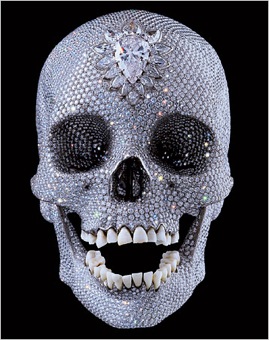
I've been thinking a bit more about Benjamin's essay with relation to the current state of contemporary art. Sheila's post on capitalism and Kevin's reminder to us of Benjamin's statement: "war only can set a goal for mass movements on the largest scale while respecting the traditional property system" have urged me to readjust my considerations, so allow me to come back to our former reading a bit.
This idea of "aura" is part of what was Benjamin was so taken with in the discussion of our old ways before film/photo -- and ability for a market to exist (a place for dissemination and commidification of art objects) is what seems to spring naturally out of the kind of reproducibility that Benjamin is suspicious of. However, self-referentiality within visual work and an in-house critique of what counts as art had been developing since DuChamp. Sol Lewitt's ideas about art laid a framework for the concept trumping even the making of the work, so that artists working today like Murakami can have a factory and be just as interested in the business aspect WITHOUT losing a side of Benjamin's aura. In fact, I would argue that the aura of this work is so much of what makes it successful -- but the context in time and place becomes something more about the artist making that piece in an art market.
For those of you who might not be familiar with Murakami, he is a great example of an contemporary artist who is using the market to both problematize our current art world's obsession with commodification while also cleaning up (finalncially) because of it. You may have heard of his Louis Vuitton store installed into museum spaces within his larger exhibition; Murakami sells products on an infinite scale, from figures you can buy in vending machines in Japan to paintings that go for millions.

Other artists are also painfully aware of the market - consider Damien Hirst's diamond skull (which he sold to a group of investors that included himself) or Jeff Koons, a former businessman turned artist sensation. It is an increasing theme in the art world, and I wonder how Benjamin might think about it in terms of evolution from his "property relations" theory.

In his post, Matt called our attention to questions about experiencial art and what actually constitutes the real work of art. I think of a French theorist who is writing about contemporary art named Bourriaud, whose last book Postproduction discusses the tendency for artists to use already made cultural objects and information to make new work. (His book prior, Relational Aesthetics, talked all about contemporary art that is not reproducible because the work exists only in experience and cultural exchange.) In a globalized culture of internet and international exchange, Postproduction suggests an emerging tendency for art to use pre-made elements (movies, cultural brands, images) to constitute a unique piece. This kind of appropriation and re-framing seems to openly acknolwedge this "aura" that Benjamin is so attached to, but remixes it and samples to make new meaning.
No comments:
Post a Comment